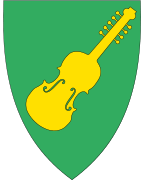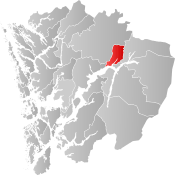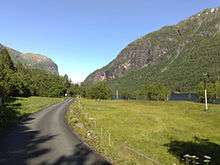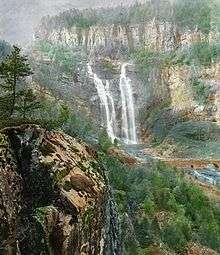Granvin
Granvin is a former municipality in the old Hordaland county, Norway. The municipality existed from 1838 until its dissolution in 2020 when it merged with Voss Municipality. The municipality was located in the traditional district of Hardanger. The administrative centre of Granvin was the village of Eide, which is also called "Granvin". About half of the residents of the municipality lived in the municipal centre. The rest lived in the rural valley areas surrounding the Granvin Fjord or the lake Granvinsvatnet in the central part of the municipality.
Granvin herad | |
|---|---|
View of the village of Granvin | |
 Coat of arms  Hordaland within Norway | |
 Granvin within Hordaland | |
| Coordinates: 60°31′37″N 06°43′10″E | |
| Country | Norway |
| County | Hordaland |
| District | Hardanger |
| Established | 1 Jan 1838 |
| Disestablished | 1 Jan 2020 |
| Administrative centre | Eide |
| Government | |
| • Mayor (2011-2019) | Ingebjørg Winjum (V) |
| Area | |
| • Total | 211.28 km2 (81.58 sq mi) |
| • Land | 203.86 km2 (78.71 sq mi) |
| • Water | 7.42 km2 (2.86 sq mi) 3.5% |
| Area rank | 326 in Norway |
| *Area at municipal dissolution. | |
| Population (2019) | |
| • Total | 933 |
| • Rank | 403 in Norway |
| • Density | 4.6/km2 (12/sq mi) |
| • Change (10 years) | -4.5% |
| Demonym(s) | Gravensar[1] |
| Time zone | UTC+01:00 (CET) |
| • Summer (DST) | UTC+02:00 (CEST) |
| ISO 3166 code | NO-1234 |
| Official language form | Nynorsk[2] |
| Created as | Formannskapsdistrikt in 1838 |
| Succeeded by | Voss in 2020 |
| Website | granvin |
Prior to its dissolution in 2020, the 211-square-kilometre (81 sq mi) municipality is the 326th largest by area out of the 422 municipalities in Norway. Granvin is the 403rd most populous municipality in Norway with a population of 933. The municipality's population density is 4.6 inhabitants per square kilometre (12/sq mi) and its population has decreased by 4.5% over the last decade.[3]
General information

The parish of Graven (later spelled "Granvin") was established as a municipality on 1 January 1838 (see formannskapsdistrikt law). This new municipality was very large and it included two annexes to the parish: Ulvik and Eidfjord. On 1 January 1859, "Ulvik" became the main parish, so that Granvin and Eidfjord became annexes to Ulvik, and the name of municipality was changed accordingly.
On 1 May 1891, the western annex of Granvin (population: 1,331) and the southeastern annex of Eidfjord (population: 1,018) were both separated from Ulvik to become separate municipalities. On 1 January 1964, the Lussand-Kvanndal area of Kinsarvik municipality (population: 72) were transferred to Granvin.[4]
On 1 January 2020, the neighboring municipalities of Granvin and Voss were merged into a new large municipality called Voss.[5]
Name
The municipality (originally the parish) is named after the old "Granvin" farm (Old Norse: Grǫnvin), since the first Granvin Church was built there. The first element is grǫn which means "spruce" and the last element is vin which means "meadow" or "pasture". Granvin is one of few parishes in Western Norway with spruce forests.[6]
The name of the parish was spelled as "Graven" before 1858. It was then spelled as "Granvin" from 1858 until 1891. Then the old spelling of "Graven" was used again briefly from 1892 to 1898. Since 1898 the spelling of "Granvin" has been used.
Coat of arms
The coat of arms was granted on 13 May 1988. The arms show a hardanger-fiddle (Hardingfele), which is a Norwegian folk instrument. Granvin is situated in the Hardanger region, and has an active folk-music tradition.[7]
Churches
The Church of Norway had one parish (sokn) within the municipality of Granvin. It is part of the Hardanger og Voss prosti (deanery) in the Diocese of Bjørgvin.
| Parish (sokn) | Church name | Location of the church | Year built |
|---|---|---|---|
| Granvin | Granvin Church | Granvin | 1726 |
Geography

The municipality was situated along both sides of the Granvin Fjord (a small arm off of the main Hardangerfjorden) and the valley extending inland from the end of the fjord, in the region of Hardanger. The large lake Granvinsvatnet lies right in the center of the valley, just north of the village of Eide. On both sides of the fjord and valley, there are high mountains. Espeland Falls is located in the Espelandsdalen valley near the border with Ulvik. The Skjervefossen waterfall is also located in Granvin.
Transportation
Norwegian National Road 13 enters Granvin via the Tunsberg Tunnel which runs through the high mountains to the northwest. The highway then runs through Granvin before entering the Vallavik Tunnel which runs through the high mountains to the southeast. The Vallavik Tunnel connects up with the Hardanger Bridge in Ulvik which crosses the Hardangerfjorden. A car ferry service connects Kvanndal (in southwest Granvin) with the villages of Utne and Kinsarvik (in Ullensvang municipality) on the south side of the Hardangerfjord. From 1935 to 1988, Hardanger railway line ran between Granvin and Vossevangen. The line was closed in 1988 and the rails were later removed.
History
| Year | Pop. | ±% |
|---|---|---|
| 1951 | 1,158 | — |
| 1960 | 1,102 | −4.8% |
| 1970 | 1,039 | −5.7% |
| 1980 | 996 | −4.1% |
| 1990 | 1,036 | +4.0% |
| 2000 | 1,044 | +0.8% |
| 2010 | 947 | −9.3% |
| 2017 | 933 | −1.5% |
| Source: Statistics Norway. | ||
In April 1940, during the German invasion of Norway during World War II, there was some fighting between German and Norwegian forces in Granvin. German forces landed in the village of Granvin on 25 April as part of their pincer movement towards the Norwegian military camps at Vossevangen. There was fighting at Skjervefossen for most of that day, until the Norwegian forces retreated late at night to avoid encirclement. Four Norwegian soldiers and at least 30 German soldiers fell in the fighting.[8]
The population of Granvin had been dropping in recent years. In 1951, the population was 1,158. Since then, it has dropped by 21.3% to 911 in 2014. This situation is common in many smaller, rural municipalities in Norway.[9]
Government
All municipalities in Norway, including Granvin, are responsible for primary education (through 10th grade), outpatient health services, senior citizen services, unemployment and other social services, zoning, economic development, and municipal roads. The municipality is governed by a municipal council of elected representatives, which in turn elect a mayor.[10] The municipality falls under the Bergen District Court and the Gulating Court of Appeal.
Municipal council
The municipal council (Heradsstyre) of Granvin was made up of 13 representatives that are elected to four year terms. The party breakdown of the council is as follows:
| Party Name (in Nynorsk) | Number of representatives | |
|---|---|---|
| Labour Party (Arbeidarpartiet) | 2 | |
| Conservative Party (Høgre) | 2 | |
| Centre Party (Senterpartiet) | 5 | |
| Socialist Left Party (Sosialistisk Venstreparti) | 1 | |
| Liberal Party (Venstre) | 3 | |
| Total number of members: | 13 | |
| Party Name (in Nynorsk) | Number of representatives | |
|---|---|---|
| Conservative Party (Høgre) | 3 | |
| Centre Party (Senterpartiet) | 4 | |
| Socialist Left Party (Sosialistisk Venstreparti) | 1 | |
| Liberal Party (Venstre) | 5 | |
| Total number of members: | 13 | |
| Party Name (in Nynorsk) | Number of representatives | |
|---|---|---|
| Labour Party (Arbeidarpartiet) | 6 | |
| Conservative Party (Høgre) | 2 | |
| Centre Party (Senterpartiet) | 4 | |
| Liberal Party (Venstre) | 1 | |
| Total number of members: | 13 | |
| Party Name (in Nynorsk) | Number of representatives | |
|---|---|---|
| Labour Party (Arbeidarpartiet) | 3 | |
| Conservative Party (Høgre) | 1 | |
| Centre Party (Senterpartiet) | 5 | |
| Socialist Left Party (Sosialistisk Venstreparti) | 2 | |
| Liberal Party (Venstre) | 2 | |
| Total number of members: | 13 | |
| Party Name (in Nynorsk) | Number of representatives | |
|---|---|---|
| Labour Party (Arbeidarpartiet) | 2 | |
| Conservative Party (Høgre) | 2 | |
| Centre Party (Senterpartiet) | 6 | |
| Socialist Left Party (Sosialistisk Venstreparti) | 1 | |
| Liberal Party (Venstre) | 2 | |
| Total number of members: | 13 | |
| Party Name (in Nynorsk) | Number of representatives | |
|---|---|---|
| Labour Party (Arbeidarpartiet) | 2 | |
| Conservative Party (Høgre) | 2 | |
| Centre Party (Senterpartiet) | 6 | |
| Socialist Left Party (Sosialistisk Venstreparti) | 1 | |
| Liberal Party (Venstre) | 2 | |
| Total number of members: | 13 | |
| Party Name (in Nynorsk) | Number of representatives | |
|---|---|---|
| Labour Party (Arbeidarpartiet) | 2 | |
| Conservative Party (Høgre) | 2 | |
| Centre Party (Senterpartiet) | 6 | |
| Socialist Left Party (Sosialistisk Venstreparti) | 1 | |
| Liberal Party (Venstre) | 2 | |
| Total number of members: | 13 | |
| Party Name (in Nynorsk) | Number of representatives | |
|---|---|---|
| Labour Party (Arbeidarpartiet) | 3 | |
| Conservative Party (Høgre) | 2 | |
| Centre Party (Senterpartiet) | 6 | |
| Liberal Party (Venstre) | 2 | |
| Total number of members: | 13 | |
| Party Name (in Nynorsk) | Number of representatives | |
|---|---|---|
| Labour Party (Arbeidarpartiet) | 3 | |
| Conservative Party (Høgre) | 2 | |
| Centre Party (Senterpartiet) | 6 | |
| Joint list of the Liberal Party (Venstre) and Christian Democratic Party (Kristelig Folkeparti) | 2 | |
| Total number of members: | 13 | |
| Party Name (in Nynorsk) | Number of representatives | |
|---|---|---|
| Labour Party (Arbeidarpartiet) | 3 | |
| Conservative Party (Høgre) | 2 | |
| Centre Party (Senterpartiet) | 7 | |
| Joint list of the Liberal Party (Venstre) and Christian Democratic Party (Kristelig Folkeparti) | 1 | |
| Total number of members: | 13 | |
| Party Name (in Nynorsk) | Number of representatives | |
|---|---|---|
| Labour Party (Arbeidarpartiet) | 4 | |
| Centre Party (Senterpartiet) | 7 | |
| Local list for Granvin (Bygdelista for Granvin) | 2 | |
| Total number of members: | 13 | |
| Party Name (in Nynorsk) | Number of representatives | |
|---|---|---|
| Labour Party (Arbeidarpartiet) | 4 | |
| Centre Party (Senterpartiet) | 7 | |
| Local List(s) (Lokale lister) | 2 | |
| Total number of members: | 13 | |
| Party Name (in Nynorsk) | Number of representatives | |
|---|---|---|
| Labour Party (Arbeidarpartiet) | 4 | |
| Centre Party (Senterpartiet) | 6 | |
| Liberal Party (Venstre) | 3 | |
| Total number of members: | 13 | |
| Party Name (in Nynorsk) | Number of representatives | |
|---|---|---|
| Labour Party (Arbeidarpartiet) | 3 | |
| Centre Party (Senterpartiet) | 7 | |
| Liberal Party (Venstre) | 3 | |
| Total number of members: | 13 | |
| Party Name (in Nynorsk) | Number of representatives | |
|---|---|---|
| Labour Party (Arbeidarpartiet) | 3 | |
| Centre Party (Senterpartiet) | 7 | |
| Liberal Party (Venstre) | 3 | |
| Total number of members: | 13 | |
| Party Name (in Nynorsk) | Number of representatives | |
|---|---|---|
| Labour Party (Arbeidarpartiet) | 3 | |
| Farmers' Party (Bondepartiet) | 8 | |
| Liberal Party (Venstre) | 1 | |
| Joint List(s) of Non-Socialist Parties (Borgarlege Felleslister) | 1 | |
| Total number of members: | 13 | |
| Party Name (in Nynorsk) | Number of representatives | |
|---|---|---|
| Labour Party (Arbeidarpartiet) | 3 | |
| Joint List(s) of Non-Socialist Parties (Borgarlege Felleslister) | 9 | |
| Total number of members: | 12 | |
| Party Name (in Nynorsk) | Number of representatives | |
|---|---|---|
| Local List(s) (Lokale lister) | 12 | |
| Total number of members: | 12 | |
| Party Name (in Nynorsk) | Number of representatives | |
|---|---|---|
| Local List(s) (Lokale lister) | 12 | |
| Total number of members: | 12 | |
| Party Name (in Nynorsk) | Number of representatives | |
|---|---|---|
| Labour Party (Arbeidarpartiet) | 1 | |
| Joint List(s) of Non-Socialist Parties (Borgarlege Felleslister) | 11 | |
| Total number of members: | 12 | |
Notable residents
- Lars Jonson Haukaness (1863-1929), an impressionist painter
- Hans Dahl (1849-1937), an artist specializing in landscape paintings
- Olav Medaas (1926-2019), 3 times champion in Norwegian national shooting competition, also a military worldchampion.
In popular culture
Granvin is a major setting in Moe Cidaly's short story "Summer Episode".[28]
References
- "Navn på steder og personer: Innbyggjarnamn" (in Norwegian). Språkrådet.
- "Forskrift om målvedtak i kommunar og fylkeskommunar" (in Norwegian). Lovdata.no.
- Statistisk sentralbyrå (2017). "Table: 06913: Population 1 January and population changes during the calendar year (M)" (in Norwegian). Retrieved 2017-10-24.
- Jukvam, Dag (1999). "Historisk oversikt over endringer i kommune- og fylkesinndelingen" (PDF) (in Norwegian). Statistisk sentralbyrå.
- "Ein Ny Kommune" (in Norwegian). Retrieved 2017-10-24.
- Rygh, Oluf (1919). Norske gaardnavne: Nordre Bergenhus amt (in Norwegian) (12 ed.). Kristiania, Norge: W. C. Fabritius & sønners bogtrikkeri. pp. 484, 486.
- "Civic heraldry of Norway - Norske Kommunevåpen". Heraldry of the World. Retrieved 2014-05-19.
- Hansteen, Wilhelm (1971). Operasjonene til lands på Vestlandet og i Hallingdal og Numedal (in Norwegian). Oslo. pp. 170–183.
- "Population changes in municipalities 1951-2014. Granvin" (in Norwegian). Statistics Norway. Retrieved 2014-05-22.
- Hansen, Tore, ed. (2016-05-12). "kommunestyre". Store norske leksikon (in Norwegian). Kunnskapsforlaget. Retrieved 2019-04-06.
- "Table: 04813: Members of the local councils, by party/electoral list at the Municipal Council election (M)" (in Norwegian). Statistics Norway.
- "Tall for Norge: Kommunestyrevalg 2011 - Hordaland". Valg Direktoratet. Retrieved 2020-02-02.
- "Kommunestyrevalget 1995" (PDF) (in Norwegian). Oslo-Kongsvinger: Statistisk sentralbyrå. 1996. Retrieved 2020-05-14.
- "Kommunestyrevalget 1991" (PDF) (in Norwegian). Oslo-Kongsvinger: Statistisk sentralbyrå. 1993. Retrieved 2020-05-14.
- "Kommunestyrevalget 1987" (PDF) (in Norwegian). Oslo-Kongsvinger: Statistisk sentralbyrå. 1988. Retrieved 2020-05-14.
- "Kommunestyrevalget 1983" (PDF) (in Norwegian). Oslo-Kongsvinger: Statistisk sentralbyrå. 1984. Retrieved 2020-05-14.
- "Kommunestyrevalget 1979" (PDF) (in Norwegian). Oslo: Statistisk sentralbyrå. 1979. Retrieved 2020-05-14.
- "Kommunevalgene 1975" (PDF) (in Norwegian). Oslo: Statistisk sentralbyrå. 1977. Retrieved 2020-05-14.
- "Kommunevalgene 1972" (PDF) (in Norwegian). Oslo: Statistisk sentralbyrå. 1973. Retrieved 2020-05-14.
- "Kommunevalgene 1967" (PDF) (in Norwegian). Oslo: Statistisk sentralbyrå. 1967. Retrieved 2020-05-14.
- "Kommunevalgene 1963" (PDF) (in Norwegian). Oslo: Statistisk sentralbyrå. 1964. Retrieved 2020-05-14.
- "Kommunevalgene og Ordførervalgene 1959" (PDF) (in Norwegian). Oslo: Statistisk sentralbyrå. 1960. Retrieved 2020-05-14.
- "Kommunevalgene og Ordførervalgene 1955" (PDF) (in Norwegian). Oslo: Statistisk sentralbyrå. 1957. Retrieved 2020-05-14.
- "Kommunevalgene og Ordførervalgene 1951" (PDF) (in Norwegian). Oslo: Statistisk sentralbyrå. 1952. Retrieved 2020-05-14.
- "Kommunevalgene og Ordførervalgene 1947" (PDF) (in Norwegian). Oslo: Statistisk sentralbyrå. 1948. Retrieved 2020-05-14.
- "Kommunevalgene og Ordførervalgene 1945" (PDF) (in Norwegian). Oslo: Statistisk sentralbyrå. 1947. Retrieved 2020-05-14.
- "Kommunevalgene og Ordførervalgene 1937" (PDF) (in Norwegian). Oslo: Statistisk sentralbyrå. 1938. Retrieved 2020-05-14.
- "Summer Episode". moecidaly.com. 2016. Archived from the original on 2016-09-27.
| Wikimedia Commons has media related to Granvin. |
External links



- Municipal fact sheet from Statistics Norway (in Norwegian)

